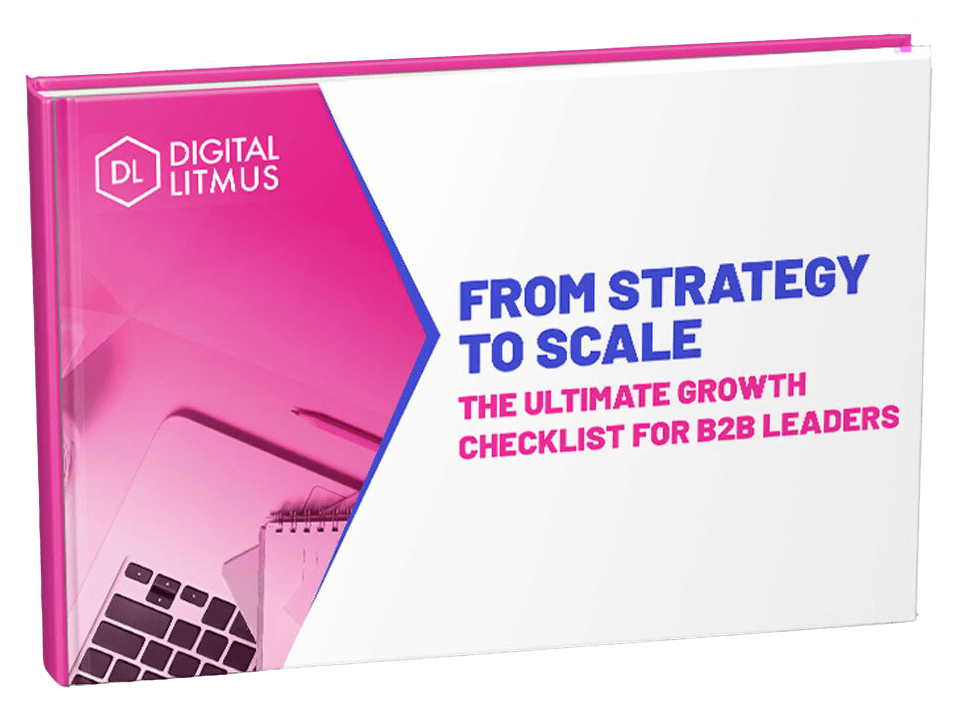We've all experienced it. The moment when your phone rings. “May I speak to the business owner?” asks the caller on the other end. “I’d like to discuss upgrading your telephone systems.”
These frequent and irritating interruptions commonly lead to us informing the caller that we aren’t interested and hanging up the phone, which is exactly why we're here to discuss inbound lead generation.
Inbound lead generation? is a solution that can save your business from being that annoying, disruptive cold caller that’s constantly giving people a headache.
Inbound lead generation is a key component of inbound marketing - a buyer-centric approach to winning new customers for your business. Inbound marketing blends many different types of content and marketing channels to consistently generate new leads and sales for your business. It does this by commonly offering useful content and building trust with your prospects or clients.
In comparison to outbound marketing, inbound marketing often provides a better return on investment for SMEs. This is because it generates more sales due to the higher quality of leads it produces and it costs 62% less per lead on average. This makes it highly valuable for SME businesses looking to invest their time in bringing in more sales without busting their budget.
In this guide, we’ll be exploring lead generation definitions, how to qualify and score a lead, some lead generation strategies, tips for your lead generation campaigns and some useful tools and resources to use.
Ready to find out how you can start generating high-quality inbound leads today? Let’s get started!
Contents
5 tips for lead generation campaigns
What is a Lead?
A lead is a contact or company who has converted on your website or through some other interaction with your organisation beyond a subscription sign-up. As a lead, an individual would hear from a business who they've already opened communication with through an interaction, as opposed to a cold caller who purchased their details.
An example of how a lead would open communication with your business would be filling out a form to download a piece of content from the website - like an ebook. You could then email them information about the content, such as how to download it or suggest other content they may be interested in.
The information you collect about the lead through the form submission can be used to help you personalise the opening communication to address the lead’s existing needs and problems. As leads have just entered the top of the sales funnel with this initial interaction, most are not yet sales-ready. To keep track of where the lead is in relation to their journey down the sales funnel, CRM systems such as HubSpot use various customer lifecycle stages.
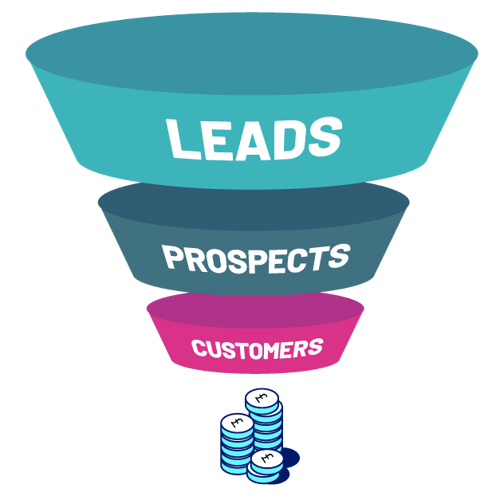
Why Not Just Buy Leads?
Buying leads, as opposed to organically generating them, is much easier and takes far less time and effort, despite being more expensive. However, any purchased leads do not actually know your business. Typically, they have ‘opted in’ at another site when signing up for something, and didn't actually opt in to receive sales messages from you.
If the prospect has never been to your website or indicated an interest in your products or services, then they are most likely not going to be interested. This also creates a high chance that they could flag your message as spam which isn’t good for your business. It’s always better to generate leads organically than to buy them.
What is Lead Generation?
Lead generation is the process of attracting and converting a prospect into someone who has indicated an interest in your company's product or services. Some examples of lead generators include blog posts, contact us forms and webinars.
For B2B companies, lead generation is a key way to warm up potential customers and move them down the sales funnel towards a sale.
Examples of how to generate leads:
- A visitor discovers your business through one of your marketing channels, such as a website, blog or social media page.
- That visitor clicks on your call-to-action (CTA) which is often an image, button or message that encourages website visitors to take an action.
- The CTA takes the visitor to a landing page, which is a website page designed to capture lead information in exchange for an offer.
An offer is the content that’s being displayed on the landing page. The offer must have enough perceived value to a visitor to merit providing their personal information in exchange for access to it.
The form on your landing page consists of a series of fields that collect information in exchange for the offer. Forms are typically hosted on landing pages, although they can technically be embedded anywhere on your site. Once a visitor fills this out, they would then be considered a lead.
Lead Generation Marketing
Once the landing page and offer have been set up, promotional channels can be used to drive traffic to the landing page and start generating leads. But what channels are best to promote the landing page?
This chart shows the flow from promotional marketing channels to a generated lead:
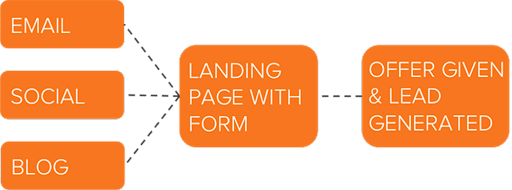
Content
Content is a great way to guide users to a landing page. Typically, content is created to offer visitors useful and free information. CTAs can be included anywhere and the more delighted a visitor is with your content, the more likely they are to click the CTA and move onto the landing page.
Email is a great way to reach people who already know the brand and product or service. It is much easier to ask them to take an action since they have previously subscribed to your mailing list.
Ads and Retargeting
The main purpose of an ad is to get people to take an action. If you want people to convert, be sure that the landing page and offer match exactly what is promised in the ad, and that the action for users to take is clear.
Blog
The great thing about using your blog posts to promote an offer is that the entire piece can be tailored to the end goal. This makes the CTA highly relevant and easy to click.
Social Media
Social media platforms make it easy to guide your followers to take action, from LinkedIn thought leadership videos to Facebook posts with a CTA in the caption.
Product Trials
It’s possible to break down barriers to a sale by offering trials of the product or service. Once a prospect is using your product, they can be enticed with added offers or resources to encourage them to buy.
How to Qualify a Lead
Essentially, a sales lead is generated through collected information which could come as the result of a lot of different actions. For example, a prospect sharing contact information in exchange for a free trial, or a person filling out a form to download an educational piece of content. These show that the amount of collected information used to qualify a lead and the lead level of interest can vary.
Free Trial
An individual that fills out a demo form is willing to share a lot of personal information because he/she is intrigued to find out the viability of a product or service. Filling out the form shows their true interest, therefore qualifying the person as a lead for your company's marketing or sales teams.
Content
While the submission of a free trial form shows an individual has a direct interest in your product or service, content (like an educational ebook or webinar) doesn’t. To truly understand the nature of the person's interest in your business, you'll most likely need to collect more information to decide whether the person is interested in your product or service and whether they're a good fit.
These two examples highlight how lead generation differs from company to company, and from person to person. You'll need to collect enough information to gauge whether someone has a true, valid interest in your product or service. So how much information is enough information will vary depending on your business.
Let's look at RocheMartin’s form on one of their ebook landing pages for example. They use web content forms for lead generation and collect six pieces of information from prospective leads.
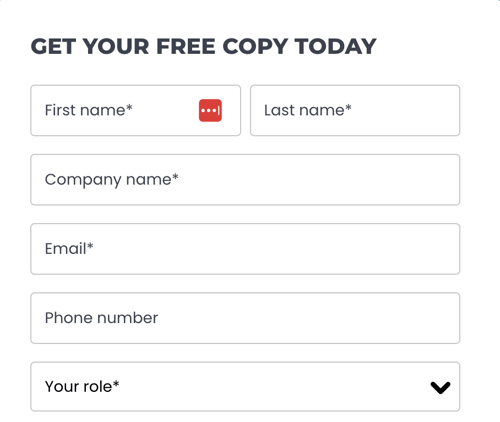
1. First and last name - The most fundamental information needed for you to personalise the communication with each lead.
2. Company name - This gives you the ability to research the lead’s industry and company, and how they might benefit from the product or service.
3. Email - This serves as a unique identifier and is how you will contact the lead.
4. Phone number - This will act as a secondary method for contacting potential customers. It is usually used when a prospect is further in the buyer journey than just being at the lead stage.
5. Role - Understanding an individual's role will help you understand how to communicate with them (based on their buyer persona). Every brand stakeholder will have a different take and perspective on your offering.
Lead Generation Scoring
Lead scoring is a way to qualify leads quantitatively. Using this technique, leads are assigned a numerical value (or score) to determine where they fall on the scale from ‘interested’ to ‘ready to buy’. It’s essential that the criteria for these actions are uniform across your marketing and sales department for it to effectively work.
A lead’s score can be based on actions they’ve taken, the information they’ve shared, their level of engagement with your brand, or other criteria that your sales team determines. For instance, you may score someone higher if they regularly engage with your business on social media or if their demographic information matches your target audience.
Borrowing from the examples above, you might give a lead a higher score if they completed a free trial, as this would signify this person is interested in your product or service.
The higher a lead’s score, the closer they are to becoming a sales-qualified lead (SQL), which is only one step away from becoming a customer. The score and criteria are something you may need to tweak along the way until you find the formula that works. But once you do, you’ll transform your lead generation into customer generation.
Ready to skyrocket your online presence? Explore our Inbound Marketing services today!
B2B SaaS Lead Generation Strategies
Online lead generation encompasses a wide range of tactics, campaigns, and strategies depending on the platform(s) on which you use to capture leads. We talked about lead capture best practices once you have a visitor on your site, but how can you get them there in the first place?
Let’s dive into lead generation strategies for a few popular B2B platforms.
Facebook Lead Generation
Facebook has been a method for lead generation since its start. Originally, companies could use outbound links in their posts and information in their bios to attract strangers to their websites. But when Facebook Ads was launched in 2007 and its algorithm began to favour accounts that used paid advertising, there was a major shift in how businesses used the platform to capture leads. Facebook created Lead Ads for this purpose. Facebook also has a feature that lets you put a simple CTA button at the top of your Facebook Page, helping you send people directly to your website.
Twitter Lead Generation
Twitter offers Twitter Lead Gen Cards (as well as other ad formats) which let you generate leads directly within a tweet without having to leave the site. A user's name, email address, and Twitter username are automatically pulled into the card, and all they have to do is click ‘Submit’ to become a lead.
LinkedIn Lead Generation
LinkedIn has been increasing its stake in the advertising space since its early days. When it comes to lead generation, LinkedIn has many ad options, but like Twitter has created Lead Gen Forms, which auto-populate with a user’s profile data when they click a CTA, making it easy to capture information.
PPC Lead Generation
When we say pay-per-click (PPC), we’re referring to ads on search engine result pages (SERPs). Google gets 3.5 billion searches a day, making it prime real estate for any ad campaign, especially lead gen. The effectiveness of your PPC campaign relies heavily on a seamless user flow, as well as your budget, target keywords and a few other factors.
5 Tips for Lead Generation Campaigns
In any given lead generation campaign, there can be a lot of moving parts. It can be difficult to tell which parts of your campaign are working and which need some fine-tuning.
Here are 5 tips for creating a best-in-class lead generation campaign:
1. Keep Your Messaging Consistent and Deliver on Your Promise
The highest-converting lead gen campaigns are the ones that deliver on what they promise and create a seamless transition from ad copy and design to the deliverable itself. Make sure that a consistent message is presented throughout the process and provides value to everyone that engages with your lead capture.
The aspects of your lead gen campaign should mirror everything else on your website, blog and within the product. If not, you’ll have a difficult time getting your lead to the next lifecycle stage. Your campaign should be about more than just obtaining an email address — it should be about developing a new customer.
2. Link Your CTA to a Dedicated Landing Page
Don't use CTAs to drive people to your homepage, for example. Even if your CTA is about your brand or product (and perhaps not an offer like a download), you should still be sending them to a targeted landing page that's relevant to what they are looking for and includes an opt-in form. If you have the opportunity to use a CTA, send them to a page that will convert them into a lead.
3. Get Your Sales team Involved
Lead scoring can’t be done without your sales team’s input. Your marketing and sales teams need to be aligned on the definitions and the process of moving a lead from MQL to SQL to opportunity before you even begin to capture leads.
Be open to evolving your relationship with sales and how you guide leads along your funnel. Your definitions will likely need to be refined over time, so make sure to keep everyone involved up-to-date.
4. Use Social Media Strategically
While marketers typically think of social media as best for top-of-the-funnel marketing, it can still be a helpful and low-cost source for lead generation. The key is using social media strategically.
Start by adding links directly to the landing pages of high-performing offers within your Facebook, Twitter, LinkedIn, and other social media posts. Tell visitors that you're sending them to a landing page. That way, you're setting expectations.
5. Create Amazing Offers for All Stages
Someone at the beginning of the buyer's journey might be interested in an informational piece like an ebook or a guide, whereas someone who's more familiar with your company and near the bottom of the journey might be more interested in a free trial or demo.
Although it takes time to create valuable content that teaches and nurtures your leads down the funnel, if you don't offer anything for visitors who aren't ready to buy, then they may never come back to your website.
If you want to take personalisation a step further (which will help boost your conversion rate), try using smart CTAs. Smart CTAs detect where a person is in the buyer’s journey - whether they're a new visitor, a lead, or a customer - and display CTAs accordingly.
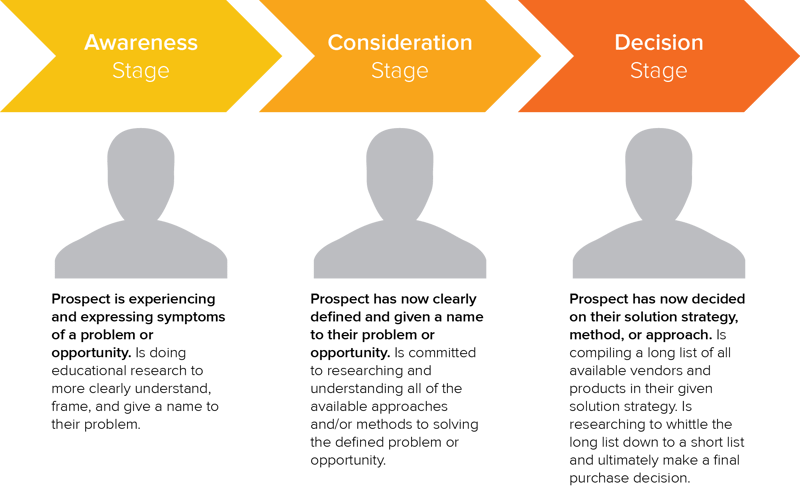

Are you a B2B company looking to accelerate growth?
Our connected sales, marketing, and HubSpot agency services might be just the ticket. Get in touch for your free growth assessment to find out how you can accelerate business growth today.

